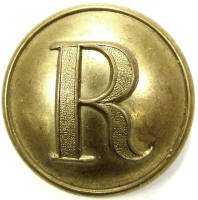
A virtual examination of artifacts of the American Civil War
 |
Ridgeway Civil War Research Center, A virtual examination of artifacts of the American Civil War |
| Civil War Artillery | |
| by Harry Ridgeway |
| Rifled artillery projectile, James design, Federal manufacture, bursting shell, "case shot"iron balls packed in sulfur matrix, open base with slots, lead and tin sleeve sabot, tie ring base, James percussion fuze, James 14 pounder rifle, 3.8in. Projectile was manufactured in the Federal arsenals following the invention of Charles James. The pattern utilized a hollow caged cavity (called a "birdcage") covered by a thin sleeve of lead, tin, and canvass, the thin sabot would expand into the rifling, and then be discharged after the projectile left the bore. This meant that there always be flying metal debris which could be a problem for forward troops . Four small holes were drilled into the base, these are thought to have been vent holes, however they are often lead filled. A ring around the base was originally installed to hold an iron cup, however it appears the iron cup may not have been used and the tie ring either was abandoned or used to secure the powder bag. Shell is " case shot", explosive charge with iron balls, packed in sulfur matrix. It is highly unusual for a shell to be equipped with a percussion fuze and case shot, normally case shot shells use time fuzes to explode near an enemy line without needing to strike the target. However, at least one battery was given percussion fuzed case shot shells, any that actually hit the target would also have spread case shot, it is doubtful this was effective. Fuze employed was the James brass anvil percussion fuze, "West Point" two part fuze, Jones pg. 30 . Projectile measures: diameter 3.7in., length 6.75in. weight 11lbs, with sabot, and case shot. Research Center: Artillery4425-James, Ref: Dickey & George, Field Artillery (1993 Edition), pg. 189. Details click: http://relicman.com/artillery/Artillery4425-James.html. |
| Ridgeway Civil War Research Center, A virtual examination of artifacts of the American Civil War. Artillery Research center, artillery, click: http://relicman.com/artillery/Artillery0000-Index.html. Research center, artillery, click: http://relicman.com/artillery/Artillery0000-Index.html. |
| Civil War Relicman, Harry Ridgeway, Civil War artillery, Relicman sales catalog. Click here: http://relicman.com/artillery/RelicmanSalesArtillery1.html. Artillery for sale: http://relicman.com/artillery/RelicmanSalesArtillery1.html. |